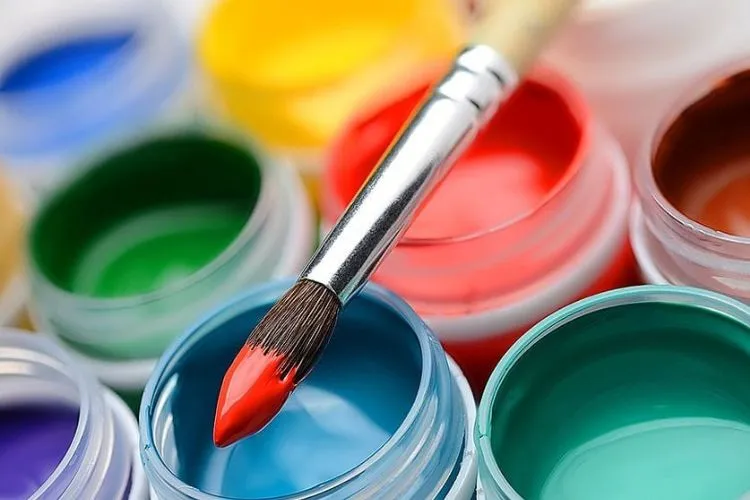In the world of art and crafts, acrylic paint is a staple. Known for its versatility and vibrant colors, it’s used by artists of all skill levels, from beginners to professionals.
However, mishaps occur, and a common concern arises – Is acrylic paint dangerous If swallowed?
This question is especially pertinent to those with young children or pets. This article delves into the composition of acrylic paint, its potential health risks if ingested, and the immediate steps you should take.

Is Acrylic Paint Dangerous If Swallowed?
Acrylic paints are popular due to their fast drying time and ability to be used on a wide range of surfaces. Unlike oil-based paints, acrylics are water-based, which influences their safety profile.
The main components of acrylic paint include pigment for color, acrylic polymer emulsion as the binder, and water. This composition makes acrylic paint more user-friendly, especially in non-ventilated spaces.
Potential Health Risks of Ingesting Acrylic Paint
The health risks associated with ingesting acrylic paint mostly stem from the chemical components used for pigmentation and stability.
Short-term effects might occur shortly after ingestion. These can include stomach upset, nausea, or vomiting. These symptoms are usually mild and often resolve without needing medical attention. The body reacts to the unfamiliar substance by trying to expel it.
When it comes to long-term effects, these are rare but can happen in cases of repeated exposure or ingestion of significant amounts. There’s a concern about the heavy metals that some pigments might contain, which could lead to toxicity if consumed over time.
However, most acrylic paints marketed for home use adhere to strict safety standards to minimize such risks.
Special considerations need to be given to children and pets. Their smaller body size and different metabolism rates mean that even small amounts of acrylic paint can be more troubling for them.
What to Do If You or Someone Else Ingests Acrylic Paint

If ingestion happens, follow these steps:
Immediate steps: It’s vital to assess how much paint was ingested. If it’s a small amount, providing water or milk to help dilute the substance is often enough. Do not induce vomiting unless advised by a medical professional.
When to call a doctor or poison control: If the person ingested a significant amount, shows symptoms of distress, or if the paint is known to contain toxic materials, seek professional medical advice immediately. Always have the paint’s brand and ingredients on hand when calling for help.
Tips for prevention and safe use: Always supervise children during painting activities. Store paints out of reach of children and pets. Choose paints labeled as non-toxic, especially for use by children.
Understanding Acrylic Paint Composition
Understanding the composition of acrylic paint is key to recognizing its potential health impacts when ingested. Acrylic paint is a popular medium in art for its versatility and the vibrant results it can produce.

Its unique composition allows it to dry quickly and adhere to a wide range of surfaces, from canvas to wood and beyond. This adaptability comes from its three principal components: pigment, binder, and vehicle.
Pigments are finely ground particles that give paint its color. These can be natural, such as minerals or clays, or synthetic. While pigments themselves often pose minimal risk if ingested in small quantities, some can contain heavy metals like cadmium or lead, especially in older or specialized paints, which could be toxic.
The binder, typically an acrylic polymer emulsion, holds the pigment particles together and adheres them to the painted surface once the paint dries.
This acrylic polymer is generally considered non-toxic and safe for use, even in children’s paints. However, when ingested, it can contribute to the bulk of material that may cause gastrointestinal discomfort.
Water acts as the vehicle or solvent in acrylic paints, dissolving the binder and allowing the paint to be easily spread. Upon drying, the water evaporates, leaving the pigment and binder on the surface. The use of water as the primary solvent makes acrylic paint less toxic and less flammable compared to oil-based paints, which use chemical solvents.
In tiny amounts, the ingestion of water-based acrylic paint may result in mild, transient gastrointestinal upset due to the body’s response to ingesting a non-food substance.
However, the main concern arises from the pigments and any added stabilizers or preservatives that can be toxic in larger quantities.
Understanding the chemical makeup of acrylic paints illuminates why they’re generally safe for use but also why caution is warranted if they’re ingested, especially in terms of the specific pigments and additional chemicals they might contain.
You may also read: Is Acrylic Paint Lead Free? | Is Acrylic Paint Good for Face Painting?
Frequently Asked Questions (FAQs)
Can a small amount of acrylic paint on my hands pose a risk if I eat with my hands?
It’s always best to wash your hands thoroughly after using acrylic paints. While a tiny amount might not cause harm, avoiding ingestion in any form is wise.
Are all brands of acrylic paint non-toxic?
While many are, it’s important to read labels. Look for paints that comply with ASTM D4236, indicating they’ve been evaluated for toxicity.
What should I do if my child swallows a small amount of acrylic paint?
Give them a drink of water or milk to dilute the paint. Observe for any distress and contact a healthcare provider for advice.
How toxic are acrylic paints to pets?
As with humans, the toxicity can vary. Prevent pets from accessing paint and consult a vet if ingestion occurs.
Can swallowing acrylic paint cause long-term health issues?
The risk is minimal with non-toxic, water-based acrylics. However, avoid repeated exposure or ingestion.
Conclusion:
While acrylic paint offers a world of creative potential, it’s essential to use it with care. The risk of serious health issues from accidental ingestion is low, especially with non-toxic, water-based acrylic paints.
Nonetheless, it’s crucial to take precautions, particularly with young children and pets.
By understanding the potential risks and knowing what steps to take in case of ingestion, you can ensure a safer environment for everyone involved in artistic endeavors. Always prioritize safety alongside creativity.

Meet Isabella Anderson, your acrylic painting mentor with over a decade of brush-wielding mastery. Dive into the colorful world of acrylics with her expert guidance, featured exclusively on ‘Acrylic Authority.’ Unleash your inner artist and explore the limitless possibilities of this versatile medium alongside a true acrylic aficionado.
